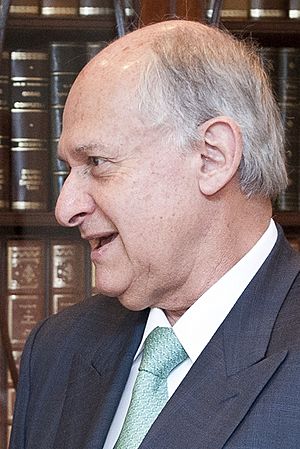Manuel Elkin Patarroyo facts for kids
Quick facts for kids
Manuel Elkin Patarroyo
|
|
|---|---|
 |
|
| Born |
Manuel Elkin Patarroyo Murillo
November 3, 1946 |
| Died | January 9, 2025 (aged 78) |
| Education | National University of Colombia (MD) |
| Known for | SPf66 Malaria vaccine |
| Medical career | |
| Profession | Physician-scientist |
| Institutions |
|
| Sub-specialties | Pathologist |
| Research | Immunology |
| Awards |
|
Manuel Elkin Patarroyo Murillo (born November 3, 1946) is a Colombian scientist. He is a Professor of Pathology (the study of diseases) and Immunology (the study of the body's defense system). He is famous for trying to create the world's first synthetic vaccine against malaria.
Malaria is a serious disease caused by a tiny parasite called Plasmodium falciparum. This parasite is carried by mosquitoes and can make people very sick. Sadly, it causes many deaths each year in warm, tropical places around the world.
Patarroyo developed his vaccine, called SPf66, in Colombia in 1987. The WHO (World Health Organization) tested it in countries like Gambia, Tanzania, and Thailand. The results were mixed, meaning it worked better in some places than others.
Later, in 2009, a big review found that the SPf66 vaccine was not very effective in Africa and Asia. However, it showed some helpful results in South America, reducing malaria cases by about 28%. Scientists are still working hard to find a universal vaccine that can protect everyone from malaria.
Patarroyo has received several awards for his work, including the TWAS Prize in 1998.
Developing a Malaria Vaccine
Manuel Patarroyo's main goal was to create a vaccine to fight malaria. This disease is a huge problem, especially in tropical areas. He worked to develop a vaccine that could teach the body's immune system to fight off the malaria parasite.
His vaccine, SPf66, was special because it was a synthetic vaccine. This means it was made in a laboratory using chemicals, rather than from a weakened or dead form of the actual parasite. This was a new and exciting way to create vaccines at the time.
Research and Animal Studies
Manuel Patarroyo began his research using animals in the 1980s. He used monkeys, especially a type called Night monkey, for his studies. These monkeys were important for understanding how the malaria parasite works and how a vaccine might protect against it.
There were some discussions and concerns about how these monkeys were obtained for research. Colombian authorities looked into the permits for using these animals. Scientists and officials worked to make sure that research involving animals followed proper rules and ethical guidelines. The goal was to balance important scientific discovery with the welfare of the animals used in research.
See also
 In Spanish: Manuel Elkin Patarroyo para niños
In Spanish: Manuel Elkin Patarroyo para niños

